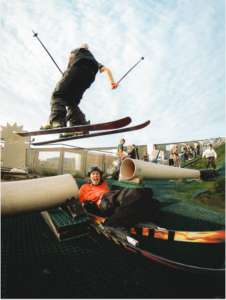17-year-old Varvara Tkachenko explains how she’s learned to love snowboarding on an artificial slope

Scandinavian Team Battle at CopenHill artificial ski slope, Copenhagen, Denmark, June 2024.
Picture by: Joachim Clausen Hansen
Article link copied.
April 11, 2025
How skiers and snowboarders are adapting to climate change

As a 17-year-old from Ukraine, I have been snowboarding since I was nine. I have fallen in love with this sport as it incorporates snow, mountains, nature and an amazing community.
Due to the war in my home country, I moved to Copenhagen 18 months ago, and decided to try freestyle snowboarding – a branch of snowboarding that includes tricks on various obstacles and big air jumps. I found sessions at CopenHill, an artificial ski slope in the middle of the city. After meeting many other free skiers and snowboarders, I realised how popular dry-slope skiing is becoming and that it is directly linked to climate change.
Changing weather patterns and a decrease in real snow is problematic for both amateur and professional skiers, encouraging the development of artificial snow and dry-slopes, leaving the ski season itself for competitions and bigger events.
Harbingers’ Weekly Brief
Global temperatures have been rising by an average of 0.2°C per decade, and are projected to rise by 1.5°C by 2050. In the Alps, as a consequence of global warming, snowfall has decreased by at least 34% over the past 100 years. As a result, many European ski resorts have shortened their ski season (usually from early November to early April) by an average of 36 days – more than a month.
This directly affects tourism, but also professional skiers and snowboarders, as it gives them less time to practice on real snow. Competitions have faced cancellation and rescheduling due to lack of snow. Therefore, alternatives are being created – such as dry slopes.
This directly affects tourism, but also professional skiers and snowboarders, as it gives them less time to practice on real snow.

Friday Night Freestyle at CopenHill in Copenhagen.
Picture by: Joachim Clausen Hansen
Competitions have faced cancellation and rescheduling due to lack of snow. Therefore, alternatives are being created – such as dry slopes.
The International Ski & Snowboard Federation (FIS) and World Meteorological Organization (WMO) are together raising awareness about the upcoming consequences of climate change on the skiing industry.
“The climate crisis is obviously far bigger than FIS − or sports, for that matter: it is a genuine crossroads for mankind. It is true, though, that climate change is, simply put, an existential threat to skiing and snowboarding. We would be remiss if we did not pursue every possible effort that is rooted in science and objective analysis,” said Johan Eliasch, FIS president in their joint press release.
Environmentalists are also warning us about the drastic effects of climate change. Daniel Scott, geography and environmental professor at the University of Waterloo, Canada, explained that “the record-breaking temperatures this winter [2023/24] provided a preview of the future. It tested the limits of snowmaking in many areas and altered millions of skiers’ ski visits and destination choices.”
The future of winter sports
Yet, the future isn’t hopeless. Skiers and snowboarders have been adapting to innovations that allow them to practice new tricks all year round. Places like Banger Park in Austria, for example – an outdoor freestyle park created five years ago using plastic brushwood slopes and airbags. Here, professional sportsmen can prepare for the competition season and practice when the snow isn’t reliable, and new snowboarders and skiers can get into the sport.
Indoor slopes that use artificial snow are also popular. Sno Oslo is a well-known indoor resort used by many Scandinavian slopestyle skiers, as Oslo is relatively central and easy to get to. People can purchase ski passes and rent skis to enjoy the large slope made of fake snow, and there are also gyms, bowling, ice-climbing and restaurants.
“I got an email from a guy who runs a ski resort in the Czech Republic asking to be connected to manufacturers – he said they can’t guarantee snow anymore, so he wants to put in a dry slope,” said ski writer Patrick Thorne to the BBC. Thorne lives in Inverness, Scotland, and has skied on about 50 dry slopes.

CopenHill is on top of a waste-incinceration plant in Copenhagen, Denmark.
Picture by: Joachim Clausen Hansen
Denmark has invented not only an alternative solution for skiing, but also a sustainable one. CopenHill is the first ever waste-incineration power plant with an urban park on the top, including an artificial ski slope (made of plastic brushwood), hiking trails, a rock climbing wall and a rooftop cafe.
For me, it is an amazing opportunity to practice my sport regardless of the weather conditions here. We have freestyle training once a week where we share tricks and tips to prepare for the winter season.
Climate change threatens many other sports as well, due to increased temperatures and high humidity, such as cycling, running and football. But it also raises the question of which sports aren’t affected?
Indoor sports such as volleyball or martial arts, for instance, are at a lower risk, yet the relationship between sport and climate change could be described as ambiguous. As much as our sports are at risk due to climate change, climate change is directly affected by the emissions produced by sports.Therefore, for many reasons, we need to adapt.
Alternatives are being developed by the day and expanding opportunities for athletes and simply those who enjoy snowboarding and want to progress, like me. If we can “send it”on the snow, we can definitely do it on those dry slopes.
Written by:

Contributor
Kyiv, Ukraine | Copenhagen, Denmark
Born in 2007 in Kyiv, Ukraine, Varvara studies in Copenhagen, Denmark and plans to pursue her bachelor’s degree at the University of Amsterdam in the PPLE (Politics, Psychology, Law, and Economics) program.
She is interested in music, travelling, snow sports, Ukrainian culture, politics, and movies, For Harbingers’ Magazine, she writes about music, movies, culture, and sports.
In her free time, Varvara enjoys snowboarding, playing piano, crocheting, knitting, and horse riding. She also studied in France for a year, learning the language, and has been participating in debates for three years, from traditional debating formats to Model United Nations (MUN).
Varvara speaks Ukrainian, English, French, and Russian.
Edited by:

🌍 Join the World's Youngest Newsroom—Create a Free Account
Sign up to save your favourite articles, get personalised recommendations, and stay informed about stories that Gen Z worldwide actually care about. Plus, subscribe to our newsletter for the latest stories delivered straight to your inbox. 📲
© 2025 The Oxford School for the Future of Journalism


